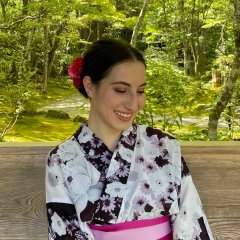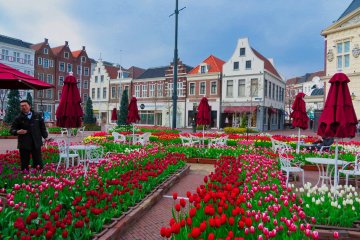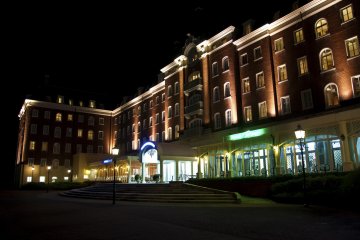Kyushu, one of Japan’s southernmost islands, is a vibrant region brimming with breathtaking nature, rich history, treasured art, and a unique balance of traditional aesthetics and foreign-influenced culture. Today, we’re going to shine a spotlight on Nagasaki and Saga Prefecture, both of which are located in western Kyushu.
Sharing coastlines with the sea, these two prefectures have something for everyone, from Nagasaki’s famous Netherlands-inspired amusement park to Saga’s porcelain-adorned shrine. In the ocean, Nagasaki’s collection of picturesque islands transports you to a captivating realm where lush verdancy meets cobalt waters. In Saga, a hidden pottery village preserves prestigious kilns from the Edo period (1603–1868), offering a nostalgic and artistic atmosphere. In fact, northern Kyushu, including Nagasaki and Saga, is known as the birthplace of Japanese porcelain, and today, both prefectures still carry on their distinctive ceramic legacies, producing some of Japan’s most beloved porcelain.
As a base to explore it all, Hotel Lorelei is conveniently situated in Sasebo, Nagasaki—just a 20-minute drive from Arita, a quaint pottery town in Saga. It is also just a one-minute walk from JR Huis Ten Bosch Station, which offers direct access to popular stations, like Nagasaki, Hakata, Arita, and Sasebo. With spacious guest rooms, natural hot spring baths, restaurants featuring local favorites, and plentiful amenities, Hotel Lorelei will bring your Kyushu adventure to the next level. If you are looking for hotels near Huis Ten Bosch, this accommodation also checks that box.
Let’s take a closer look at things to do in Nagasaki and Saga. These destinations may just inspire your next Japan adventure. Consider this article your Saga and Nagasaki travel guide!
What can I do in Nagasaki and Saga?
Nagasaki Sightseeing
History and culture

As one of Japan’s first areas to facilitate trade with the West, Nagasaki has a fascinating history shaped by international influence. Today, these past chapters are still visible in Nagasaki—rooted in the countless European-style buildings and large Christian population.
The area around Sasebo Station perfectly captures this confluence of Japanese and Western elements. Here, the Miura Catholic Church, boasting stunning Gothic architecture, is just a five minutes’ walk from the traditional vermilion structures of Kurokamizan Daichiin Temple.
For shopping enthusiasts, Tunnel Yokocho Shopping Street has a variety of stores uniquely located inside air raid shelters built during WWII. The street is known for its Showa-era (1926–1989) vibes and is a popular spot among locals. Saruku City 4○3 Arcade also offers plenty of shopping opportunities. The one-kilometer street is considered the longest arcade in Japan and houses over 160 shops. The covered street allows you to enjoy the various souvenir shops, clothing stores, restaurants, and cafes no matter the weather.

For a look into the city’s traditional crafts, be sure to visit Sasebo Koma Hompo, a handicraft shop that specializes in Sasebo spinning tops. With a history of roughly 300 years, these handmade tops are known for their distinctive shape and extended metal tip. You can spin it normally or use it as a “trick top” that spins on a stick or in the palm of your hand. The top’s vibrant patterns emerge as it rotates, creating an artistic effect. This traditional Japanese toy and performance culture represents a fusion of craftsmanship and playful creativity. The shop offers Sasebo-painting workshops, so you can create your own special design.

From Sasebo Station, the renowned Huis Ten Bosch theme park is just a 25-minute train ride away. This widely popular facility is considered Japan’s largest theme park and beautifully recreates the atmosphere of the Netherlands. From its cobblestone streets and canals to its eye-catching windmills and Dutch architecture, Huis Ten Bosch will make you feel as though you have traveled to Europe. The theme park hosts stunning seasonal flower events, Kyushu’s biggest fireworks festival, one of the world’s largest illumination displays, and Nagasaki’s lantern festival.

For one of Nagasaki’s most captivating remnants of the past, we must travel into the ocean. Hashima Island, also known as Gunkanjima Battleship Island, is an abandoned island about 30 minutes by boat from Nagasaki Port. This 480-meter-long and 160-meter-wide island once thrived as a coal mining town and at its peak, was home to 5,300 people. However, after the coal mines closed in 1974, the island was quickly abandoned.
Today, it is registered as a UNESCO World Heritage Site and draws visitors with its dilapidated buildings and eerie, frozen-in-time landscape. Given its impactful visuals, it inspired the villain’s hideout in the James Bond film, Skyfall. You can explore this island with cruises and landing tours.

Nagasaki City also serves as a hotspot for historical and cultural exploration. Starting with the Nagasaki Atomic Bomb Museum, this meaningful facility documents pre- and post-bomb Nagasaki, the events leading up to the atomic bombing, and modern efforts toward nuclear abolition. The museum aims to pass on the horrors of war and nuclear weapons to future generations so such an unspeakable tragedy never occurs again.
Nearby, the Nagasaki Peace Park is a tranquil area dedicated to those who died during the atomic bombing. Across the greenscape, there are several sculptures that capture the devastation of the tragedy, as well as the hope for future peace. At the Hypocenter Park, a black monolith marks the explosion’s epicenter. Together, the destinations create an incredibly important and moving experience.
About 20 minutes away via Nagasaki’s electric tramway, Dejima was the only place in Japan open to Europe, specifically the Netherlands, during the country’s roughly 200 years of national isolation. Once an artificial island, this area now serves as an open-air museum, featuring preserved residences, warehouses, walls, and gates—allowing you to step into Japan’s trading past.

South of Dejima, the Oura Cathedral and Glover Garden also shine as multi-cultural landmarks in Nagasaki. Built in 1864, Oura Cathedral is Japan’s oldest surviving Christian church and was the first Western-style building in Japan to be designated as a national treasure. It boasts beautiful contemporary European architecture and offers insight into the history of Christianity in Japan.
About a two-minute walk away, Glover Garden is an open-air museum that showcases several mansions where foreign residents once resided. The garden’s most famous landmark is the Glover House, the former residence of Scottish merchant Thomas Glover. Glover played an important role in Japan’s modernization, and today, his home is the oldest wooden Western-style building in Japan. The garden is known worldwide as the setting for the opera, Madame Butterfly.

If you are a fan of bridges, you will not want to miss Meganebashi, Japan’s first stone arched bridge. Literally translating to “Spectacles Bridge,” this landmark is unsurprisingly famous for its eyeglasses-like appearance—a result of the arches reflecting in the calm river below. Be sure to snap a shot of this beloved photo spot.
Nature

In addition to its cultural landmarks, Nagasaki is also home to some truly awe-inspiring nature. The Kujukushima Islands are arguably one of the prefecture’s most renowned sceneries. This stunning archipelago of over 200 islands—only four of which are inhabited—is said to have the highest island density in Japan. From the sparkling rays of morning to the orange-pink hues of sunset, the painting-like landscape of verdant islands scattered across the sea is simply breathtaking. Aside from its dreamy views, the Kujukushima area is also a major Akoya pearl-producing region. These high-quality pearls are known for their bright, mirror-like luster, perfectly round or near-round shape, and complexion of white to white-pink.
One of the best ways to soak in Kujukushima’s scenery is at one of the eight observatories in Nagasaki—called Kujukushima Hakkei (Eight Scenic Views). Each observatory showcases different perspectives of the islands, and with the subtle changes throughout the day and year, no visit is ever the same. Two of the most prominent observatories are Tenhaiko Observatory and Ishidake Observatory, with the latter being the filming location of the opening scene for The Last Samurai.

For up-close views of the islands, Kujukushima Pearl Sea Resort in Sasebo offers memorable sightseeing cruises, as well as dining and shopping options. The 50-minute rides, set aboard eye-catching ships, leisurely weave through 99 of the region’s islands, providing impressive visuals of the magnificent scenery. Sunset cruises are also available on select days, and watching the sun paint the sea golden is a truly unforgettable travel highlight.

When you are feeling peckish, dine on the area’s nationally renowned Kujukushima oysters. Thanks to the area’s mineral-rich waters, Kujukushima is one of Japan’s leading oyster-producing regions. The oysters themselves are renowned for their small size, deep flavor, plump texture, and are typically enjoyed grilled.
Spanning the Hario Strait and located in Sasebo, the Saikai Bridge is an iconic fixture that boasts lovely views of the oceanside scenery. The bridge’s newly added pedestrian walkway has sea-facing windows that overlook the strait’s renowned whirlpools—conditions permitting. Located on the bridge’s northern end, Saikaibashi Park is a simultaneously relaxing and exciting destination, home to a sled slope, playground equipment, and approximately 1,000 cherry trees.

While we’re on the topic of remarkable panoramas, the views from Mt. Inasa are some of Nagasaki’s best. Located relatively close to Nagasaki’s city center, this 333-meter-tall mountain is listed as one of the “World’s New Three Great Night Views.” While the scenery is stunning throughout the day, nighttime is especially magical. From the mountain’s summit, accessible via the Nagasaki Ropeway, the night-cloaked city glitters like a jewelry box.
Saga Sightseeing
As one of the main birthplaces of ceramics in Japan, Saga’s greatest lure is its pottery heritage, which is on full display throughout the prefecture.

Starting in Arita—a small town famous for its Arita ware—Sueyama Shrine, also known as Tozan Shrine, has a unique showcasing of this cherished porcelain. While most shrine structures are made of wood or stone, this shrine’s torii (gate), guardian dog statues, lanterns, and fence are all made of Arita ware. The porcelain’s stunning composition of blue and white seems to glow against the natural tones of the grounds, creating a shrine visit akin to an open-air museum stroll.

Approximately 20 minutes away by car, Okawachiyama Village, also known as the “Village of Secret Kilns,” is a historic pottery town that once housed the official kiln of the Nabeshima family of the Saga Domain and produced top-notch pottery for important historical figures, including members of the Imperial Court. The porcelain produced here, called Nabeshima-yaki, was among the most exclusive porcelain in Japan.
Today, the quaint village encircled by trees offers a nostalgic look into the past. Many kilns still flank the streets, and even the village’s bridges, maps, and street decorations are made of ceramic. As you explore the serene mountain village, where traditional craftsmanship harmonizes with nature, you will find yourself immersed in the true essence of Japanese beauty.
The ceramics of Nagasaki and Saga

As you are exploring the wonders of these two prefectures, why not select a stunning ceramic piece to remember your journey? Listed below are some of the prefectures’ most renowned types of porcelain.
- Hasami ware (Nagasaki): Roughly 400 years old, this ceramic type is beloved for its modern, everyday design. It is known for its practicality and beautiful white finish, with a refined aesthetic reminiscent of the Scandinavian style.
- Mikawachi ware (Nagasaki): This elegant porcelain is characterized by its delicate indigo painting. Once produced for the Hirado Domain and cherished by European royalty, it is known as the “art of white porcelain.”
- Arita ware (Saga): Regarded as Japan’s first porcelain, Arita ware is defined by its vivid reds, blues, and gold accents. In the 17th century, it was exported to Europe under the name “IMARI,” a town where tradition and innovation coexist.
- Imari ware (Saga): Originating from porcelain made in Arita and exported from Imari Port, this type of porcelain is recognizable by its bold designs and bright colors. The town continues to produce works that blend classic and modern styles.
Where can I stay in Nagasaki?
For a conveniently located home away from home, Hotel Lorelei in Sasebo, Nagasaki provides everything you need for a comfortable stay. Address-wise, the hotel’s close proximity to JR Huis Ten Bosch Station—just one minute on foot—makes sightseeing extremely easy. In fact, you can leave your luggage at the hotel and head straight to Huis Ten Bosch before you even check in. Then, after a day of merriment, you can enjoy beautiful panoramas of the theme park from the hotel’s guest rooms, restaurant terrace seats, and natural hot spring baths.

The hotel’s unique western-esque facade immediately welcomes you to Nagasaki’s multicultural atmosphere, and once you step inside the spacious lobby, a relaxing hotel stay unfurls around you.
Pleasant guest rooms

Start and end your day in comfortable luxury with the hotel’s sizable guest rooms, all of which are adorned with calming decor. The soft lighting, bright color palettes, and walkable space help guide you into a relaxed state where you can rest and recharge after the day’s travels.

The hotel has Western-style rooms, including Comfort Twin, Standard Twin, and Superior Twin, as well as Japanese-Western-style rooms. Much like Nagasaki’s melding of Western and Japanese elements, these rooms come equipped with both tatami seating areas and Western-style beds. The spacious rooms are ideal for families or large groups who are interested in experiencing Japanese culture, while still having access to homey comforts. Some guest rooms even afford views of Huis Ten Bosch.
Natural hot spring baths

Soothe your travel-weary mind and body with a soak in Hotel Lorelei’s natural hot spring baths! The water is colorless, transparent, and odorless, making it appealing for even first-time public bathers. The well-equipped facility is home to a sauna, three private open-air baths, a large indoor bath, and a public open-air bath—from which you can also enjoy views of Huis Ten Bosch.
The private open-air baths are available from 12pm–9pm and are priced at ¥1,500 for one hour. Reservations are required, and you can make one from 10:30am on the day of your visit.

The soothing burble of water, natural heat, and outdoor vistas create a rejuvenating experience that will leave you feeling refreshed and ready for another day of exploration.
Restaurants: A taste of southern Japan
Hotel Lorelei is home to two restaurants: Restaurant “Lorelei” and Buffet Restaurant “Biersong.”

Lorelei is best known for its Nagasaki and Sasebo specialties and its careful use of seasonal ingredients. The variety of menus, including lunch, tea time, family-friendly, and bar-themed, ensures that everyone has the opportunity to savor a meal that meets their desires. Here, you can dine on Nagasaki champon noodles (a popular Nagasaki noodle dish), sara udon (a Nagasaki udon-based dish), lemon steak, and other Japanese and Western dishes.
You will also not want to miss the hotel’s original “Sasebo Burger,” a special variation of Sasebo’s soul food. In fact, the hotel is a certified member of the Sasebo Burger association!
From the restaurant’s terrace seats, you can enjoy your meal outside while idly admiring Huis Ten Bosch, the river, and train stations.

If you are really hungry, indulge in Biersong’s all-you-can-eat buffet—only open for dinner on Fridays, Saturdays, Sundays, and public holidays. The high-ceilinged dining area is modeled after a German beer factory and serves 50 different Japanese, Western, and Chinese dishes. The freshly grilled steak from the live kitchen is an especially noteworthy bite. Aside from dinner, the restaurant also serves daily breakfast filled with local specialties, like Sasebo’s famous Navy Curry and grilled dried horse mackerel.
Additional facilities

If you are looking for some Nagasaki and Saga souvenirs, Hotel Lorelei’s gift shop is an excellent place to start. Peruse everything from “Castella” sponge cakes to premium ceramics, including Arita ware and Hasami ware.

Perhaps one of the hotel’s most unique features is its onsite goat, Ken-chan, who has earned celebrity status at the facility. He is an eco-friendly grass cutter and adores cabbage. Feed him his favorite food with a feeding experience!

In the pond next to Ken-chan, four wild ducks are often seen swimming freely along the canal in front of the hotel. Their return is always an adorable sight, so be sure to keep an eye out for the happy ducks.
Unlock western Kyushu’s distinctive culture
Nagasaki and Saga Prefecture are home to an engaging mix of destinations. Walk beside historical Japanese-Western architecture, explore regional crafts, spend the day at one of Japan’s most renowned theme parks, admire captivating landscapes, observe one-of-a-kind ceramics, and so much more. The possibilities are endless, and with Hotel Lorelei as your accommodation, you will feel energized and ready to explore it all.
Access

You can reach Nagasaki and Saga Prefecture by both train and plane. Nagasaki Airport services numerous flights from popular airports, like Tokyo (Haneda and Narita) and Osaka (Kansai and Itami), while Saga International Airport only has connecting flights from Tokyo. From Nagasaki Airport, Nagasaki Station is about a 45-minute bus ride. From Nagasaki Airport, you can also catch the Airport Express bus—operated by Saihi Bus—for a direct ride to Huis Ten Bosch Bus Stop (about one hour). From there, Hotel Lorelei is about a 10-minute walk.
When traveling by Shinkansen, Hakata Station in Fukuoka is the closest station to Nagasaki and Saga.
- Tokyo → Hakata: 5–5.5h
- Kyoto → Hakata: 2h 45m–3.5h
- Shin-Osaka → Hakata: 2.5h
- Hiroshima → Hakata: 1.5h
From Hakata Station, Nagasaki Station is about a 1.5-hour train ride. First, take the Limited Express Relay Kamome to Takeo-Onsen Station. Then, transfer to the Nishi Kyushu Shinkansen for Nagasaki Station. From Nagasaki Station, the JR Huis Ten Bosch Station is roughly a two-hour train ride. Alternatively, you can take the JR Limited Express Huis Ten Bosch directly from Hakata to JR Huis Ten Bosch Station. Hotel Lorelei is just a one-minute walk away!
To reach Saga Station from Hakata Station, simply hop on the Limited Express Relay Kamome for approximately 40 minutes.
































